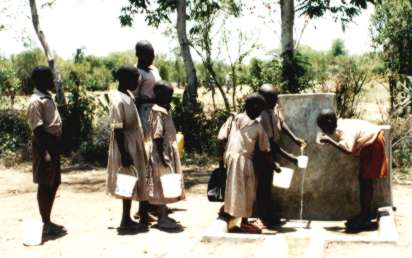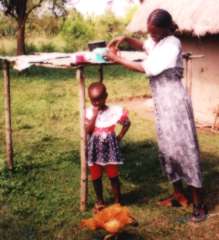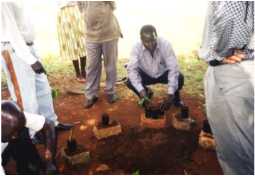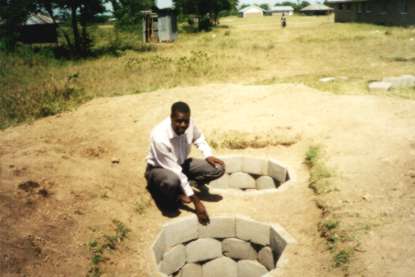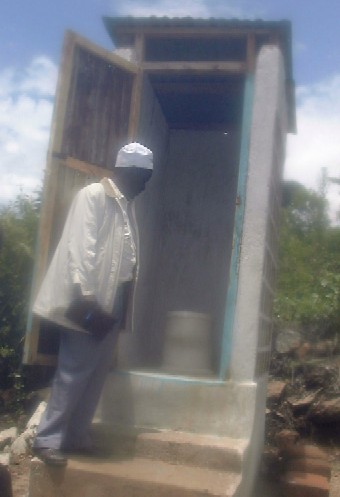Would you like to make this site your homepage? It's fast and easy...
Yes, Please make this my home page!
Sana International
Under
sanitation, with an objective of environmental Protection, health improvement
and maximising farm outputs, SANA International has introduced Ecological Sanitation
Technology in Upper Nyakach. The technology harnesses the natural process of
decomposition in converting organic matter into organic manure through special
safe storage and handling of human excreta
This
is sourced from a protected spring and it caters for the needs of up to five
communities with four sub-management and one overall management committee trained
to operate and maintain the facilities.
The
following community based integrated packages of water supply; sanitation and
hygiene training have so far been developed and tested:
ACTIVITIES
SANA
believes in sub-catchments or catchments approach to water development in
rural areas. The spring source is protected by constructing a concrete wall
fitted with flow pipes. Suitable trees are then planted upstream. This enables
users to draw water without disturbing the source.
SANA
undertakes rain water harvesting for schools and homes situated in places where
ground water is hard to strike or is unavailable. It comes with a Ferro cement
tank for water storage during rainy season. SANA encourages replication of this
by common interest groups (CIGs) and merry go-rounds.
.Rain
water harvesting through roof catchment with ferrocement tanks.........
Schools
and households roof catchments.
Spring
protection. ...........................................Back
to top
Gravity
Flow Systems ..............................................................................................Back
to top
Water
Pans.
............................................................................................................Back
to top
Water
pans are excavated surface water storage facilities of limited capacity (normally
minimum 5,000 to maximum 20,000 cubic metres). Pans are generally constructed
at sites where the topography is relatively flat. The soil scooped out is used
build the embankment around the rectangular water hole.
These are used around the rain shadow of Lake Victoria and are fitted with sand
filtration gulleries to improve the quality of drinking water. Cattle troughs
are availed to avoid contamination of water by animals.Set back in this technology
is the use of heavy machinery hence the high cost.
High
prevalence of water borne diseases amongst school going children necessitated
the development of a schools hygiene package. SANA assists schools to form Schools
Health Clubs (SHCs) for dissemination of positive hygiene messages using Participatory
Hygiene and Sanitation Transformation (PHAST). Parents Teachers Association
nominates patrons to these clubs.
Hand
dug well /hand drilled with foot pump and elevated tank
............................. Back
to top
This
technology is where a well is equiped with a preasure pump to lift water to
an elevated tank for storage. The source is normaly a high yielding borehole
or well. Water from the tank is gravitated to school and the community tapstands.
Schools
Sanitation and Health Education.
...................................................................Back
to top
Community
Health and Sanitation Education...............................................................Back
to top
Theatre for development
is supported for effective communication and message retention. The drama
incorporates use of skits, traditional songs, and dance in order to promote
improved practises in behaviour related to diarrhoeal diseases, malaria and
HIV-AIDS. These are life skills as they ensure living with knowledge and dangers
of contracting these diseases.
Construction of sanitation facilities is undertaken with about 60% contribution
by the schools. SANA supplies materials manufacture of slaps and lining blocks
for pits situated in areas with loose soils. The schools contribute materials
for super structure and labour for digging pits.
Lined
latrine pits for use in loose soil areas
Community
members use a protected Sprin. On the background is an afforested catchment
area
Rain
Water Harvesting through Water Pan fitted with sand filtration Gullery
Tree
seedlings ready for catchment conservation.
Children
pump water from a well (left) to an elevated tank (right) where water is gravitated
for use by the schools.The elevated tanks also serve neighbouring communities.
School
Children use clean containers to fetch water from a school tapstand
Copyright
© 2002, SANA International. SANA is a Non Governmental Organisation registered
in Kenya
SANA
has a wide resource of field-based staff equipped with use of Participatory
Hygiene and Sanitation Transformation (PHAST) methodology for community mobilization
and latrine construction.
Sana uses methodologies that have been developed and successfully tested in
the areas of community mobilisation, training, participatory planning, monitoring
and evaluation. Community theatre was singled out as particularly effective
in helping communities retain health and hygiene messages.
The sanitation approach
makes use of locally available materials and using the sanitation ladder,builds
on local practice. There is a strong cost sharing element whereby the community
dig and make blocks The provide all the materials for the superstructure.
SANA provides technical support and materials that are not locally available.
Emphasis
is placed on replication. SANA has adapted various types of sanitation techniques,
such as the Ecosam Options (Skyloo, Fossa alterna and arbaloo) as well as the
sunplat, VIP and double pit, lined latrine. The lined latrines are used in unstable
soils as shown in the picture on the left in unstable soils as shown in the
picture above left. Demonstrations are also given to comunities to replicate
dish racks, refuse pits and drainage for overall health improvements.


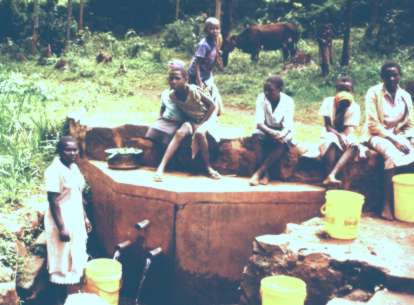
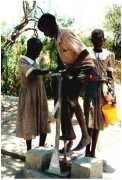

![]() Child to child training and
participatoy technics
Child to child training and
participatoy technics![]() Problem Identification
Problem Identification Problem analysis............................................................
Problem analysis............................................................
 Planning for solution
Planning for solution Planning for monitoring and evaluation
Planning for monitoring and evaluation Participatory planning, monitoring and evaluation.................
Participatory planning, monitoring and evaluation.................
![]() O&M of water and sanitation
facilities
O&M of water and sanitation
facilities